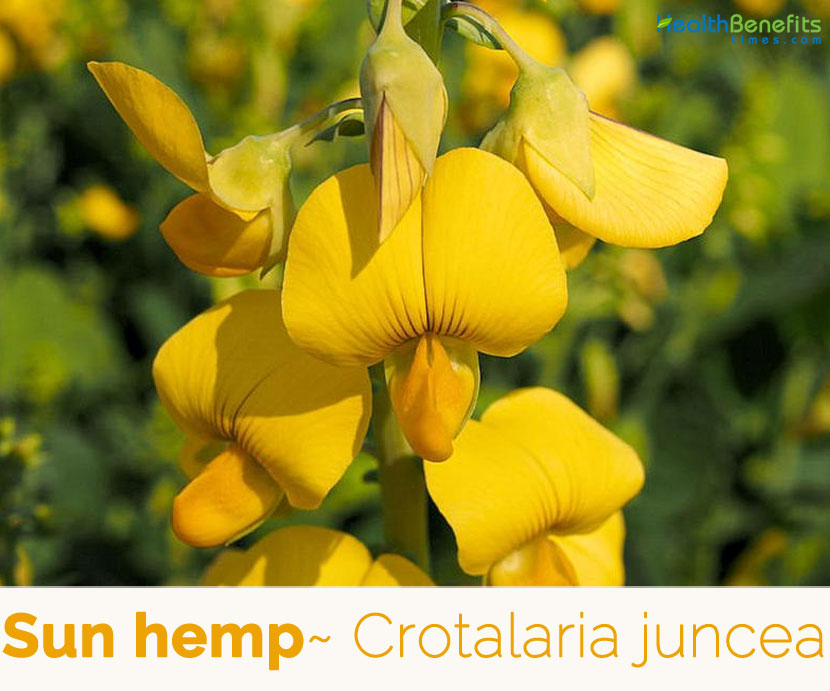| Sun hemp Quick Facts | |
|---|---|
| Name: | Sun hemp |
| Scientific Name: | Crotalaria juncea |
| Origin | Asia especially Asia tropical (Bangladesh; Bhutan; India) |
| Colors | Green when young turning to light brown as they matures |
| Shapes | Cylindrical hairy pod 3-6 cm long and 1-2 cm in diameter, short, velvety hairy, 6–12-seeded |
| Taste | Bitter |
| Health benefits | Beneficial for anemia, impetigo, menorrhagia, psoriasis, gastric and bilious fevers |
The genus name Crotalaria means rattle and is indicative of the noise made by the seeds shaken in the mature pods. The species name juncea was given to this plant by Linnaeus because of its resemblance to Spartium junceaum L., the Spanish broom of the Mediterranean region with its green rush like, scantily-leaved branches. Crotalaria juncea is the fastest growing and most important species of the Crotalaria genus. Sunn hemp is not related to industrial hemp or marijuana. It is actually in the genus Crotalaria but it is not toxic to livestock like Crotalaria spectabilis. The plant is considered as a source of green manure, fodder and lignified fiber obtained from its stem. Sunn hemp is also being looked at as a possible bio-fuel. It can be an invasive weed and has been listed as a noxious weed in some jurisdictions.
Plant Description
Sunn hemp is a multipurpose, short-day, annual, erect shrubby, tropical and subtropical legume that grows about 1 to 4 m tall. The plant is found growing in scrub jungles, dry deciduous forests, and sparse forests and along trails. The plant grows best on fairly light textured soil like sandy loam or loam of at least moderate fertility. It also grows well on clay soils and will tolerate low fertility providing that soils are well-drained. The plant has well developed, long, strong taproot with lateral roots, and much branched and lobed nodules, up to 2.5 cm in length. Stem is up to 2 cm in diameter, cylindrical and ribbed with short appressed hairs.
Leaves
Leaves are simple, about 2.5-10.5 cm long, and 6–20 mm broad, linear or oblong, obtuse or sub-acute, apiculate, pubescent on both sides, hairs appressed and silky. Leaf-stalk is about 1.2-2.5 mm long. Stipules are almost absent.
Flowers are bisexual, zygomorphic, and 5-merous. Calyx is 1.5–2 cm long, covered in short brown hairs with some longer ones interspersed, lobes 3–4 times as long as the tube. Corolla is bright yellow; with elliptical standard faintly reddish marked or tinged wings a little shorter than keel. Keel is 17–22 mm long, with a long, slightly incurved twisted beak; stamens 10, all joined in a sheath open at base. Ovary is superior, 1-celled, style curved and small stigma. Flowering normally takes place from May to September.
Fruits
Fertile flowers are followed by cylindrical hairy pod that is 3-6 cm long and 1-2 cm in diameter, short, velvety hairy and about 6–12-seeded. They are green when young turning to light brown as they matures. Seeds are small flattened, oblique, cordiform, 6-7 mm long, heart-shaped, grayish olive, dark grey or dark brown to black and loosened in the pod at maturity.
Traditional uses and benefits of Sun hemp
- Seeds are believed to purify the blood and are used in the treatment of impetigo and psoriasis.
- It is traditionally used as blood purifier, abortificient, astringent, demulcent, emetic, and purgative, in the treatment of anemia, impetigo, menorrhagia and psoriasis.
- Infusion of bitter leaves are used externally and internally for gastric and bilious fevers accompanied by skin diseases like impetigo and psoriasis.
- It is also used as emmenogogue.
- Root is used for colic and as astringent in epistaxis.
- Seeds used to purify the blood.
- Powdered seeds, mixed with oil are used to make the hair grow.
- In India, it is used for anemia, impetigo, menorrhagia, psoriasis.
Culinary Uses
- Leaves have been recorded as being eaten.
- Flowers are pickled.
- They are also cooked with meat and fish.
Other Facts
- Bark yields fiber used in making twine and cord, canvas and fishing nets, and paper and pulp.
- Fiber possesses properties that make it an excellent choice for papermaking.
- Fibers are mainly suitable for cigarette paper because of the high cellulose and low ash content.
- The strong bast fiber is used primarily for cordage, twine, fishing nets, cigarette paper, tissue paper, bags, sacks, canvas, soles of shoes and sandals.
- Other products include carpets, webbing, table and bed linen.
- With the fibers a potting medium is manufactured.
- Dried stalks and hay are used as forage.
- Sunn hemp is locally used as fodder.
- The number of seeds/kg is highly variable, ranging from 18,000 to 35,000.
- Valuable, high quality, strong fiber is extracted from the stems and bark.
- It is often planted for increasing soil organic matter to over-farmed soils, for loosening subsoil, to reduce soil erosion, conserve soil water and recycle plant nutrients.
- It has also been grown in Brazil and Bangladesh as a soil-improving crop.
- It is also grown to suppress weeds, to prevent soil erosion and to reduce nematode numbers.
- It is a good indicator plant for potassium and calcium deficiencies.
- Seeds are fed to horses in the Soviet Union and to pigs in Zimbabwe.
- Woody stems remaining after fiber removal is used as fuel.
- Seeds are used in the production of an adhesive for plywood and as a coffee-substitute.
Precautions
- Seeds of many Crotalaria species contain toxic pyrrolizidine alkaloids.
- Trichodesmine is the principal toxic alkaloid in Crotalaria juncea.
- Seeds are reported to contain trypsin inhibitors; they are said to be poisonous to cattle, and they can poison both horses and pigs.
- Avoid use during Pregnant and Breast feeding.
References:
https://www.itis.gov/servlet/SingleRpt/SingleRpt?search_topic=TSN&search_value=501804#null
https://davesgarden.com/guides/pf/go/201785/
http://www.hear.org/pier/species/crotalaria_juncea.htm
http://www.theplantlist.org/tpl/record/ild-6022
https://npgsweb.ars-grin.gov/gringlobal/taxonomydetail.aspx?id=12331
https://pfaf.org/user/Plant.aspx?LatinName=Crotalaria+juncea
https://plants.usda.gov/core/profile?symbol=CRJU
https://en.wikipedia.org/wiki/Crotalaria_juncea
https://pdfs.semanticscholar.org/ad27/3ae2f2abc696dd946957b01d87aca4366bdb.pdf
https://indiabiodiversity.org/species/show/229377
https://www.feedipedia.org/node/313
http://www.flowersofindia.net/catalog/slides/Sunn%20Hemp.html
https://gd.eppo.int/taxon/CVTJU
https://www.echocommunity.org/en/resources/808239c5-009a-49f3-8f3a-8a9790836070
https://www.nrcs.usda.gov/Internet/FSE_DOCUMENTS/nrcs142p2_053283.pdf
https://hort.purdue.edu/newcrop/proceedings1996/V3-389.html
https://uses.plantnet-project.org/en/Crotalaria_juncea_(PROTA)
https://www.cabi.org/isc/datasheet/17189
http://www.worldagroforestry.org/treedb/AFTPDFS/Crotalaria_juncea.PDF
Comments
comments
